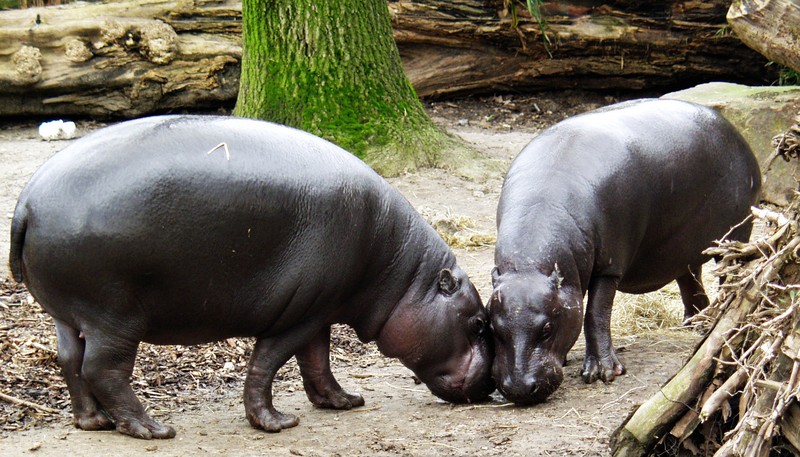|
| Query: hippo | Result: 1st of 369 | |
Pygmy Hippopotamus (Choeropsis liberiensis) - Wiki
| Subject: | Pygmy Hippopotamus (Choeropsis liberiensis) - Wiki
| |

| Resolution: 2100x1200
File Size: 730965 Bytes
Date: 2005:03:27 16:14:51
Camera: E-20,E-20N,E-20P (OLYMPUS OPTICAL CO.,LTD)
F number: f/2.0
Exposure: 1/80 sec
Focal Length: 360/10
Upload Date: 2007:01:16 10:12:18
|
Pygmy Hippopotamus
From Wikipedia, the free encyclopedia
[Photo] Zwergflusspferd - Pygmy Hippopotamus - Hexaprotodon liberiensis at Zoo Duisburg, Germany. Date 27. Mar. 2005. Author Raymond de - Raimond Spekking http://commons.wikimedia.org/wiki/User:Raymond_de
The Pygmy Hippopotamus (Choeropsis liberiensis) is a large mammal native to the forests and swamps of western Africa (the species name, meaning "of Liberia", reflects this). The pygmy hippo is an herbivore and also nocturnal. It is one of only two extant species in the hippopotamus family. Unlike its larger relative, the Hippopotamus, relatively little is known about the Pygmy Hippo's diet or behavior, although it is clear that the Pygmy Hippo is adapted to forest environments rather than the more open plains and grasslands that the Hippopotamus prefers. Some authors place the Pygmy Hippo in the genus Hexaprotodon, along with a number of fossil forms.
Pygmy Hippos stand about 75 cm (30 inches) high at the shoulder and weigh 180 kilograms (400 pounds). They are more solitary than their larger relatives and considerably less aquatic. The skin is greenish-black, shading to a creamy gray on the lower body. The average lifespan is 35 years, and one in captivity reached the age of 42. The gestation period ranges from 190-210 days, and usually a single young is born. Pygmy Hippos live either alone or in small groups, typically a mated pair and one calf.
All species of hippo spend most of their time in the water, emerging mainly at night in order to feed on land. The Pygmy Hippo is half as tall as the Hippopotamus and weighs 1/10 as much as a small member of the larger hippo species. The fossil record suggests that the Pygmy Hippo is closer in form and possibly behavior to the common ancestor.
Pygmy hippos exist in two populations. One ranges in Guinea, Sierra Leone, Liberia and C??te d'Ivoire. The other population, with a different shape to the skull, ranged until recently in the Niger Delta but may now be extinct.
There are two subspecies of the pygmy hippopotamus. Choeropsis liberiensis heslopi is a critically endangered subspecies, and may possibly even be extinct. The other subspecies, Choeropsis liberiensis liberiensis, is a category 4 (vulnerable)
http://en.wikipedia.org/wiki/Pygmy_Hippopotamus
| The text in this page is based on the copyrighted Wikipedia article shown in above URL. It is used under the GNU Free Documentation License. You may redistribute it, verbatim or modified, providing that you comply with the terms of the GFDL. |
|
Comments |
|---|
| | Guest |
|
Pygmy hippopotamus
Choeropsis liberiensis
The pygmy hippopotamus is found in West Africa, in Liberia, Sierra Leone, Guinea and Ivory Coast. It is about half the size of the Nile hippopotamus; it stand 75-100 cm at the shoulder and weighs 160-270 kg. It is basically hairless except for few hairs on the muzzle, inside the ears and on the end of the tail. The skin is black-brown and can produce an oily substance which keeps it moist. There are 4 toes on each foot, almost without webbing between them. The pygmy hippo has only one pair of incisors, while the Nile hippo has 2-3 pairs.
Pygmy hippos are solitary creatures, coming together only to mate. They live in wet forests and swamps, spending most of their time on land, unlike their larger relatives. Both sexes have home ranges; a male's is about 1.6 km2, a female's 0.4-0.6 km2. Home ranges of several animals may overlap, but they seem able to avoid each other, probably through dung marking.
The pygmy hippo's resting places are usually in wet areas, for food they go to higher grounds. They make 'tunnels' or cleared paths in the underbrush, and use these to travel through their territory. They are also excellent swimmers and can walk on the bottom of a river. The nostrils can be closed with muscular valves, which allows them to remain under water for up to 6 minutes. If threatened by a predator, like a leopard, they will try to escape into the water or into thick underbrush. Feeding takes place mainly at night. Pygmy hippos live on grasses, leaves, water plants and fallen fruits; these are digested in the complex stomach with 3 chambers.
Little is known about reproduction in the wild. Presumably it is like breeding in captivity: the male courts the female for a period of two days, mating takes place on land or in the water. The gestation period is 184-210 days. The female gives birth to a single calf which weighs about 3-4.5 kg. When the calf is born, either on land or in the water, it is already able to see, hear and walk. It is nursed for 6-8 months, 2 or 3 times a day. After 4-5 years the pygmy hippopotamus reaches sexual maturity. Its life span in captivity is 35-45 years. |
^o^
Animal Pictures Archive for smart phones
^o^
|
|
|

